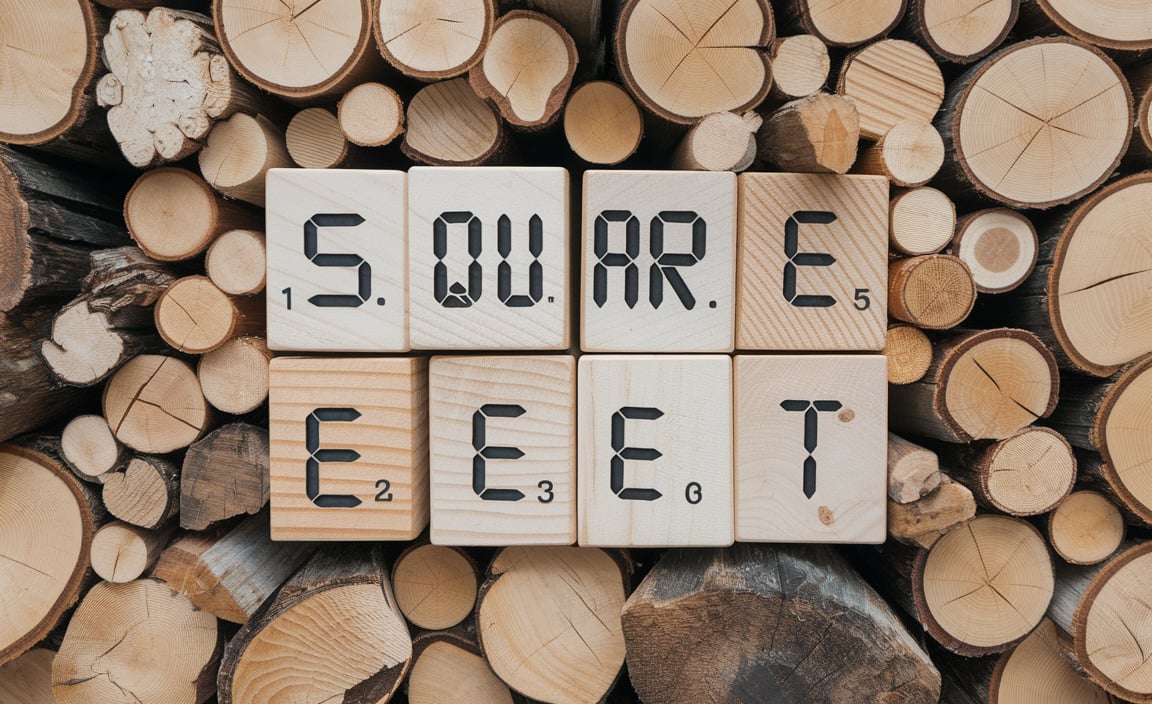Have you ever looked at a piece of wood and thought it was a bit boring? What if I told you that you could change that? You can transform wood with color! Imagine turning dull wood into a vibrant piece that catches the eye.
In this article, we will guide you step-by-step on how to do just that. You’ll learn simple ways to bring out beautiful colors in wood. It’s like painting, but even more fun because you work with a natural material.
Did you know that many furniture pieces start as plain wood? By adding color, you can create something truly unique. Whether you want to refresh an old chair or make a stunning art piece, this guide is for you. So, let’s dive in and discover the magical world of coloring wood!
Table of Contents
How To Transform Wood With Color: A Step-By-Step Guide

How to Transform Wood with Color: A Step-by-Step Guide
Want to change plain wood into a colorful masterpiece? This guide teaches you how to add vibrant hues to wood. Start by choosing the right stain or paint. Preparing the wood is key for great results. Next, follow easy steps to apply color evenly. Add a sealant for protection, and your project is complete! Did you know that colored wood can brighten up any space? Get ready to unleash your creativity!
Choosing the Right Colorants for Wood
Types of colorants: stains, dyes, and paints. Factors to consider in selecting the appropriate colorant.
Choosing the right colorant can make your wood project shine. There are three main types of colorants: stains, dyes, and paints. Each has unique qualities. Stains soak into the wood and enhance the grain. Dyes create vibrant colors and have a rich appearance. Paints cover the wood completely and provide solid colors.
When picking a colorant, consider:
- Wood Type: Some woods absorb color better.
- Desired Look: Think about whether you want a natural or bold style.
- Environment: Will it be indoors or outdoors?
Always test a small area first. This way, you’ll see how the color turns out before covering the whole piece.
What should I know about wood colorants?
Wood colorants include stains, dyes, and paints. Each type affects the appearance and lasting quality differently.
Preparing Your Workspace
Essential tools and materials needed for the project. Safety precautions to take when working with wood and chemicals.
Before you start your project, set up your workspace. Gather all essential tools and materials. You will need:
- Sawdust mask: Protects your lungs.
- Safety goggles: Keep your eyes safe from dust.
- Gloves: Shield your hands from chemicals.
- Brushes: For applying color evenly.
- Sandpaper: To smooth the wood surface.
- Wood stain or dye: Your color choice.
- Drop cloth: To keep the area clean.
Always work in a well-ventilated space. This helps reduce harmful fumes. Remember, safety first! Happy crafting!
What tools do I need for wood coloring?
You will need a brush, gloves, safety goggles, wood stain, and sanding paper. These tools help you prepare and apply color safely.
Surface Preparation Techniques
Steps to clean, sand, and treat the wood surface. Importance of proper preparation for optimal color application.
Before diving into the colorful world of wood transformations, give your surface a good scrub! First, clean the wood to remove dust and old finishes. Then, grab some sandpaper and smooth it out. This step is like giving your wood a spa day – it deserves it! Proper preparation is crucial for absolute color glory; if it’s not prepped well, the colors won’t stick like magic glue. Below are some quick steps:
| Step | Description |
|---|---|
| 1. Clean | Remove dust, dirt, and previous finishes. |
| 2. Sand | Smooth the surface with sandpaper for better adhesion. |
| 3. Treat | Apply a wood conditioner if needed. |
Remember, nothing ruins a painting party faster than messy wood! Be wise, prep right, and your colors will shine bright!
Applying Color: Step-by-Step Instructions
Detailed process for applying stains, dyes, and paints. Tips for achieving an even and desirable finish.
To add color to wood, you can use stains, dyes, or paints. Stains soak into the wood, giving it a warm look. Dyes add vibrant colors, while paints provide a solid finish. Start with sanding your wood to create a smooth surface. Apply the stain or dye using a brush or cloth. Make sure to work in the direction of the wood grain. For paint, use a wide, flat brush to cover evenly. Always allow each layer to dry fully before adding more. Tip: Test a small area first to see how the color looks. Don’t forget to wear old clothes—you might end up looking like you just fought a colorful monster!
| Product | Best Used For |
|---|---|
| Stains | Enhancing wood’s natural look |
| Dyes | Vibrant, even color |
| Paints | Solid, opaque color |
Techniques for Different Aesthetic Effects
Methods to create distressed, antique, or modern looks. Utilizing layering and blending techniques for depth.
To create different looks for wood, you can use various techniques. For a distressed finish, try sanding away parts of the wood and adding a splash of paint! Want an antique vibe? Mix dark stains with a little bit of white to get that worn-out charm. If modern is more your style, consider layering vibrant colors and using a dry brush method to create depth.
| Look | Technique |
|---|---|
| Distressed | Sanding and paint splash |
| Antique | Dark stains mixed with white |
| Modern | Layering bright colors |
Mix in some blending techniques for extra flair! Smooth transitions in colors bring out the beauty of the wood. So, grab your brushes and unleash your inner artist. Remember, making mistakes can lead to happy accidents, just like Bob Ross taught us!
Sealing and Finishing Your Colored Wood
Recommended sealers and finishes to protect the color. Importance of sealing in enhancing durability and appearance.
Once your wood is beautifully colored, it’s time to seal it! Using the right sealer can help keep that color looking fresh. Imagine slapping on a protective coat like armor for your wooden masterpiece. A good finish not only protects but also makes the colors pop! Here are some popular options:
| Type of Sealer | Benefits |
|---|---|
| Polyurethane | Durable and water-resistant. |
| Lacquer | Fast-drying with a high shine. |
| Varnish | Great for outdoor projects, protects against UV rays. |
Sealing is key to enhancing both durability and appearance. With a good sealer, your wooden wonders can survive splashes, spills, and even sticky fingers! Think of it as giving your wood a superhero cape! So, don’t skip this step; it’s where the magic happens.
Common Mistakes to Avoid
Top errors beginners make when coloring wood. How to troubleshoot and correct issues during the process.
Coloring wood can be fun, but beginners often run into a few snags. One big mistake is skipping the sanding step. Sanding smooths the surface, helping color stick better. Without it, you may end up with blotchy spots that look like a chicken danced on your project! Another error is using too much color at once. This can lead to drips and uneven shades. If that happens, don’t panic. You can lighten the color with some mineral spirits or a rag. Remember to test colors on scrap wood first!
| Mistake | Solution |
|---|---|
| Skipping sanding | Smooth the wood first |
| Using too much color | Thin layers work better |
Keep these tips in mind, and you’ll avoid common traps. You’ll transform wood like a pro and leave that chicken far behind!
Maintenance and Care for Colored Wood
Best practices for cleaning and maintaining colored wood surfaces. Longterm care tips to preserve color vibrancy and condition.
To keep your colored wood looking great, follow some simple care tips. Always use a soft cloth for cleaning. Avoid harsh chemicals that can fade colors. Regular dusting helps maintain the wood’s shine. For long-term care, consider these practices:
- Apply a protective finish every few years.
- Keep wood away from direct sunlight to prevent fading.
- Use coasters to avoid water rings.
- Check for signs of wear and repair promptly.
With just a bit of effort, you can keep your colored wood vibrant and beautiful for years.
How can I clean colored wood surfaces?
Use a damp cloth and mild soap for cleaning. Avoid soaking the wood to prevent damage.
Conclusion
In conclusion, transforming wood with color is fun and rewarding. We learned to choose the right stains, prepare the surface, and apply color evenly. Remember to experiment with different shades to find your favorite look. Now it’s time to try these steps on your own projects. Keep reading for more tips or share your creations with friends!
FAQs
What Types Of Wood Coloring Techniques Can I Use To Achieve Different Effects On My Projects?
You can use different wood coloring techniques to make your projects look amazing. One way is to stain the wood. Stains soak into the wood and change its color. Another way is to paint it. This gives a bright, solid color. You can also use a technique called wash, where you mix paint with water for a lighter look. Finally, try using markers or crayons to add simple designs. Each method can make your project unique!
How Do I Properly Prepare Wood Surfaces Before Applying Color Treatments?
To prepare wood surfaces for color treatments, start by cleaning the wood. You can use soap and water to remove dirt. Next, sand the surface to make it smooth. Be sure to wipe away dust after sanding. Finally, apply a wood primer if you want the color to stick better.
What Are The Best Types Of Stains And Dyes For Enhancing The Natural Beauty Of Wood?
To make wood look beautiful, you can use oil-based stains. They soak into the wood and show its natural grain. Water-based stains are also good because they dry quickly and are easy to clean up. If you want bright colors, try using dyes instead of stains. They can make wood look really vibrant and unique!
How Can I Protect Colored Wood To Ensure Its Longevity And Prevent Fading?
To protect colored wood, you can apply outdoor furniture oil or wood sealer. These products help keep the color bright and safe from the sun. Place your wood items in a shady spot or cover them when not in use. Cleaning them regularly with a soft cloth also helps keep them looking nice. This way, your wood will last longer and stay pretty!
What Tools And Materials Are Essential For Transforming Wood With Color Effectively?
To color wood, you need a few important tools and materials. First, get sandpaper to smooth the wood. Then, use wood stain or paint for the color. Apply it with a brush or cloth. Finally, finish with a clear coat to protect the color and shine.





